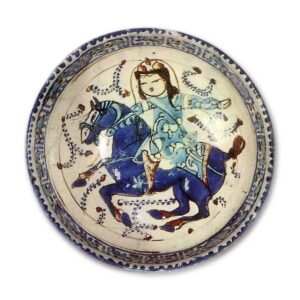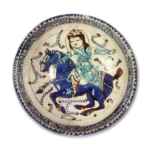
A Persian pottery produced from the middle of the 12th century to the middle of the 13th century, decorated with a variety of patterns. The technique of enameling glassware with patterns using lead oxide, which melts at low temperatures, as a solvent and uses iron, manganese, tin, copper, and other substances to produce colors, was developed in Syria.
This enameling technique was applied to pottery and at the same time was combined with Persian miniature painting techniques.
Many of the designs were taken from miniature paintings, and some of the themes even coincide with both. The use of seven colors is standard. Figures, groups of figures, trees, plants, and flowers are often used as patterns, and some depict scenes from traditional tales. This technique was eventually introduced to the West and gave rise to majolica and Ispano-Moresque painted ceramics, as well as copper-based cloisonné enamel ware in Europe, which was imported back to China and gave rise to Qing dynasty porcelain enameled soft-colored ware. The main areas of production were Kashan, Lei, and Sabe, and the brush strokes showed regional characteristics to some extent.
For example, Kashan paintings of women generally have round faces and cheeks with rounded chins, giving a Chinese impression. In contrast, Lei’s face is not rounded with a pointed chin. In addition, the hair is emphasized in abundance in the Lei style. Similarly, Kashan has a rounded chin, while Rey’s chin is pointed and angular. The cervée is somewhere in between. Horses are also often used in the pattern, but Kashan is an imposing horse, while the lei artist paints him lightly and lightly (Pope, A.). (Pope, A.U., “ASurveyofPersianArt”)








